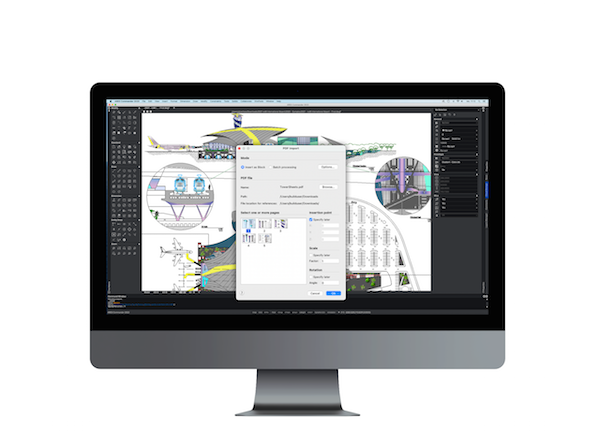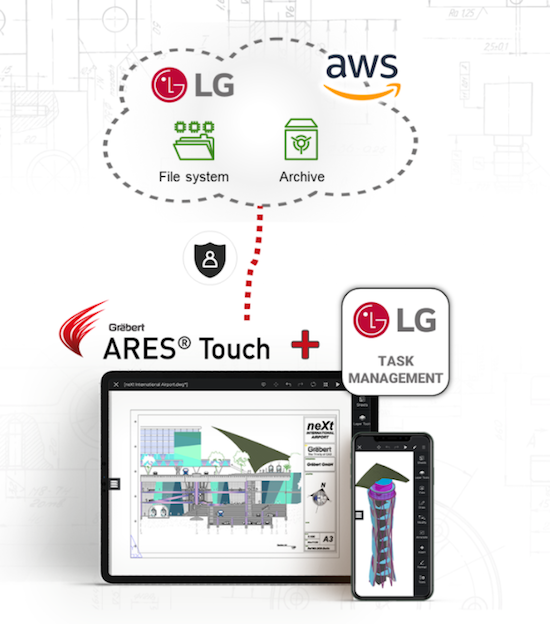Graebert, Act II: Enterprise CAD Collaboration
Graebert steps out of the background with its Trinity of CAD platform, and a greater emphasis on wide-scale collaboration

All versions of Graebert’s Ares CAD platform can import PDF files. Image courtesy of Graebert.
Latest News
December 11, 2020
For 43 years Graebert has been mostly behind the scenes in the engineering software industry, creating DWG-compatible CAD software that other vendors use to create a final product. The formula was 1 part Graebert development, 1 part partner development, and 1 part partner branding. It was a strategy that made Graebert the world’s second-most used CAD software, when you counted its partnerships with the likes of Dassault Systemès (DraftSight), Corel (CorelCAD), Esri (Esri Map, a co-branding), and PTC (Onshape’s drafting technology).
When Graebert debuted its “Trinity of CAD” platform in 2017, with separate and complementary CAD tools for desktop (Ares Commander), mobile (Ares Touch) and browser (Ares Kudo), it realized it needed to increase market presence under its own brand name. No other vendor was offering a fully compatible and full-featured drafting solution that worked on all desktops (Win/Mac/Linux) and all mobile devices with complete interoperability. Graebert also discovered their drafting platform’s collaborative features made it more interesting to enterprise customers.
“We started to change when mobile and cloud came out,” says Wilfried Graebert, the company’s founder. “We needed more contact with our end users. Before it was ‘here is our technology’; now our cloud and mobile products need explanation directly. The previous business model didn’t work.”
So far the strategy is paying off. Just before the world went into lockdown in March, Graebert introduced Ares for Enterprise at a conference in Japan. It offers the three parts of the Trinity platform with additional features designed for companies with 100 or more licenses. The Enterprise platform offers Single Sign On, special features for administrators, and help in integrating Ares into a company’s IT infrastructure. Graebert now counts the three largest construction companies in Japan as customers. It is also finding success with large customer installations in India (India Institute of Architects) and Korea (LG, Samsung, Hancom). The common element in all three nations is the presence of either an existing Graebert development office or a long-standing partnership with a local vendor. Now Graebert wants to take their success tweaking the business model to the rest of the world.

Graebert says Korean industrial giant LG selected its Trinity of CAD platform to gain a cloud service that would support its existing AWS installation and also provide custom IT management of individual mobile CAD users. Image courtesy of Graebert.
In early December Graebert held a 30-minute online conference to present the highlights of Ares 2022 — the company is skipping “2021” as a version name. For mechanical users, there is a separate version of Ares Commander designed for the needs of 2D mechanical CAD users, including factory layout planning, editing legacy data, creating conceptual sketches, and all the other ways that manufacturing companies use 2D adjacent to their 3D modeling software.
“Collaboration becomes important in this era,” explains Cedric Desbordes, Graebert’s director of marketing and business development. “Trinity addresses synchronization and session handling using auto-locking files. The key to true collaboration is integration between CAD and the user’s [IT infrastructure] environment.”
Robert Graebert, Graebert chief technical officer, explains the motivations to integrate with multiple solutions and product ecosystems: “Centralizing files in a cloud environment can bring a lot of agility and deliver more collaboration. But the value of a modern CAD environment can only be unlocked when we connect our CAD tools to your data. We realize that .DWG CAD data does not exist in isolation and when we engage with customers, very often the data hosting decisions have already been taken,” he says.
Part of the emphasis on enterprise collaboration is the introduction of Kudo Drive, an extension of its Kudo browser-based CAD that works as a central server. Kudo Drive uses Amazon’s AWS S3 technology. Graebert says most of its users may eventually use an existing cloud platform, but having Kudo Drive available at no extra cost (if on subscription) gives them an easy way to test out Graebert’s next level in DWG-based collaboration. Kudo is already compatible with existing cloud services including Microsoft Azure, AWS, Dropbox, and Box. This year Graebert adds support for the open source cloud platforms Nextcloud and WebDAV.
“There is no future in which 2D disappears,” notes Robert Graebert. “People have ambitions of having the mechanical model or the BIM model express the design. But there will still be a documentation process for a long time.” Adds Desbordes, “Workflow is essential. There is not much more to invest in basic 2D CAD, but we can generate value by improving 2D-to-3D workflow, including communications between devices.”
Other highlights from the Graebert neXt event:
- The company is introducing support in its Mac version for Apple’s new ARM-based M1 processor, making it the first CAD vendor to support this new hardware platform.
- There is new support for IFC files and Revit files, as Graebert positions itself in the AEC market as being the right-sized choice for production drafting in tandem with existing 3D building information modeling (BIM) platforms including Autodesk Revit.
- New integrations with Trimble Connect and Hancom Space (Korea’s leading solution for office suite software both on desktop and cloud)
More Graebert Coverage
Subscribe to our FREE magazine, FREE email newsletters or both!
Latest News
About the Author
Randall S. Newton is principal analyst at Consilia Vektor, covering engineering technology. He has been part of the computer graphics industry in a variety of roles since 1985.
Follow DE





